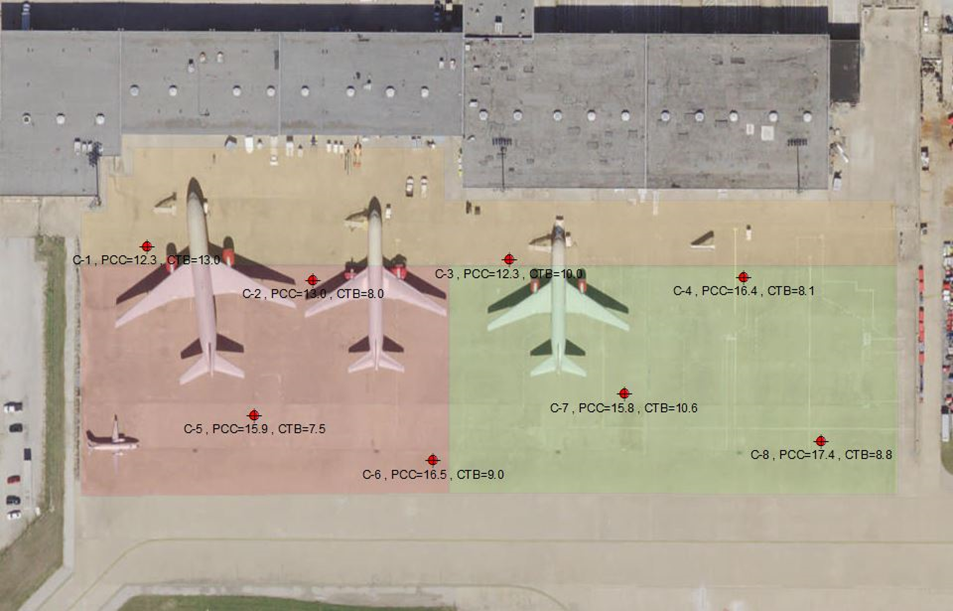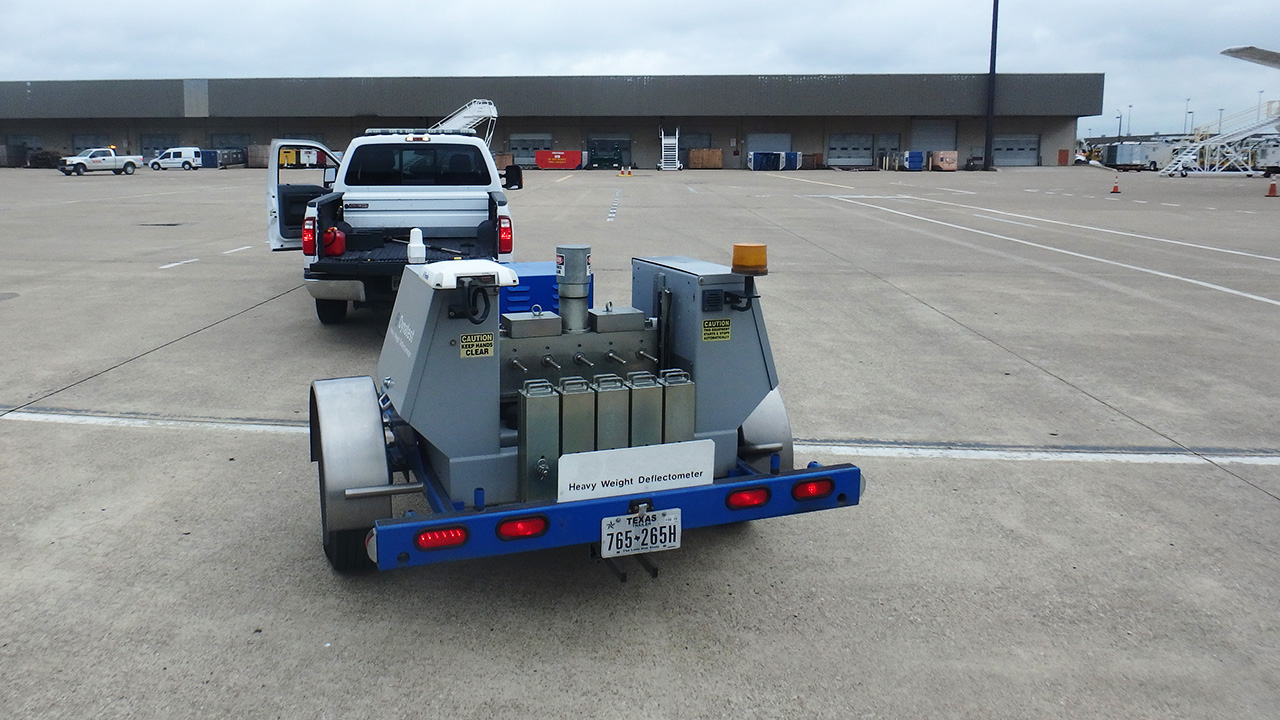CASE STUDIES
Transtec reviewed the data collected and performed engineering calculations to determine the feasibility of using the existing ramp to support loading from Boeing 747-8 aircraft. The results of this pavement analysis were submitted to the DFW Airport to assist in their evaluation of the feasibility of the proposed project. Primarily, the findings were used to determine whether the existing pavement is suitable to support the anticipated aircraft operations on the ramp.
After evaluating core data from the existing ramp pavement, Transtec found that the ramp pavement is broken up into two primary pavement sections—a northern portion (yellow in the below figure) and a southern portion (green and red in the below figure). The northern portion was found to be composed of approximately 12 to 13 inches of concrete on 8 to 13 inches of cement treated base, while the southern portion is composed of 16 to 17 inches of concrete on 8 to 10 inches of cement treated base. The northern portion of the pavement being thinner than the southern portion of the pavement is most likely due to the limited anticipated loading from the aircraft in this location.

Dynamic cone penetrometer (DCP) tests were used to evaluate the general consistency of the subbase and subgrade. The DCP testing generally suggested a variable subbase layer (lime treated subgrade) with varying thickness ranging from 6 to 8 inches, when present. However, the stiffer subbase layer was not found in all tested locations, indicating that the layer was either impacted by moisture or not present at all. This data was further validated with the non-destructive testing.
Transtec developed a Heavy Weight Deflectometer (HWD) testing plan based on the guidance of Federal Aviation Administration (FAA) Advisory Circular AC 150/5370-11B and Transtec’s past experience with similar projects. At 172 discrete test locations throughout the ramp, HWD testing was conducted to evaluate the pavement response to loading.
The HWD tests the pavement response by dropping a weight onto a loading plate and measuring the deflection of the pavement structure both under the plate and at several locations away from the plate. The measured deflection allows for characterization and analysis of the current structural performance of the existing pavement.
By conducting deflection testing throughout the ramp, the ability of the pavement to sustain the proposed airplane load can be better understood, along with documenting potential weaker or problem areas. Both mid-panel testing and joint testing were done to determine the modulus values of the different pavement layers and load transfer efficiency (LTE) respectively.

To supplement the other testing and get a better understanding of how the pavement has performed to date, RS&H conducted a visual pavement condition survey. The survey consisted of dividing the cargo ramp into a grid of 25 sample units and then conducting a visual survey of the 424 slabs. The frequency and severity of observable pavement distress across the ramp was tabulated. The results from this survey were used in conjunction with the HWD testing to evaluate structural pavement performance.
Transtec analyzed the data gathered from the geotechnical survey, non-destructive testing, and pavement evaluation. Transtec conducted backcalculation and load transfer efficiency analysis of the deflection data using FAA’s BAKFAA software along with the procedures outlined in FAA Advisory Circular AC 150/5370-11B. The results from the backcalculation were then combined with the results of the pavement condition survey to evaluate the potential for the pavement to support the anticipated aircraft loading. FAA’s FAARFIELD software was used for this analysis.
The three sections of pavement—the northern, eastern, and western portions—were considered separately in the analysis due to differences in pavement thickness and deflection data. Since the actual number of future operations is unknown, the evaluation was done for multiple scenarios to determine the feasibility of supporting fully loaded 747-8 aircraft.
Based on the evaluation completed by Transtec, the DFW Airport can now determine whether the existing pavement is suitable for their needs based on the departure capacity of the ramp, or if some structural improvements may be required.
Transtec’s team of engineers can provide airports with pavement evaluations, forensic analysis, pavement management, testing services, and project-level runway and taxiway design services. These services can help airports better understand their large pavement assets and optimize pavement rehabilitation and reconstruction strategies. Transtec can also perform routine runway pavement friction testing, evaluation of rubber deposit build-up and removal, evaluation of pavement surface macrotexture and microtexture, investigation of the root cause of low pavement friction conditions, and development of optimized corrective actions.
The Transtec Group worked with RS&H in conducting an evaluation of the Evergreen cargo ramp at the Dallas-Fort Worth (DFW) International Airport.
Transtec developed a testing and evaluation plan that included a pavement condition survey by RS&H, as well as geotechnical testing and non-destructive deflection testing provided by other firms.
CONTACT US

The Transtec Group engineers the best pavements in the world. Have a pavement problem? Give us a call—we’re good listeners.
© 2025 | The Transtec Group, Inc. | Privacy Policy